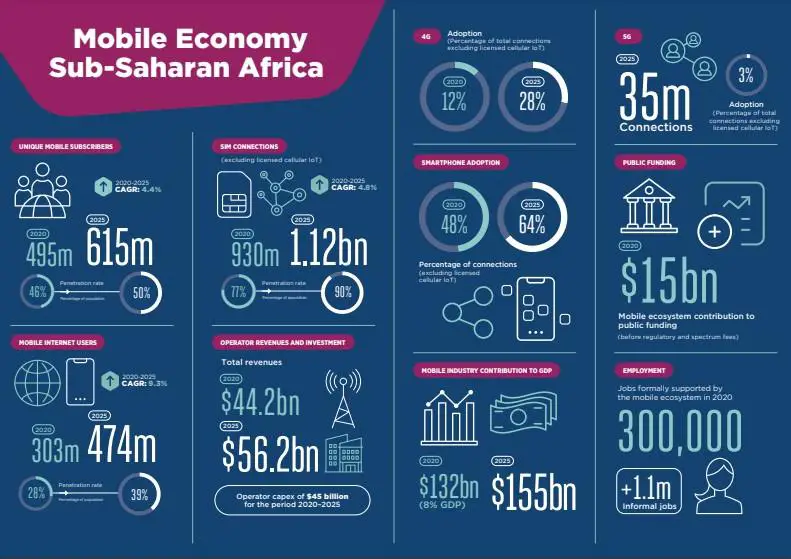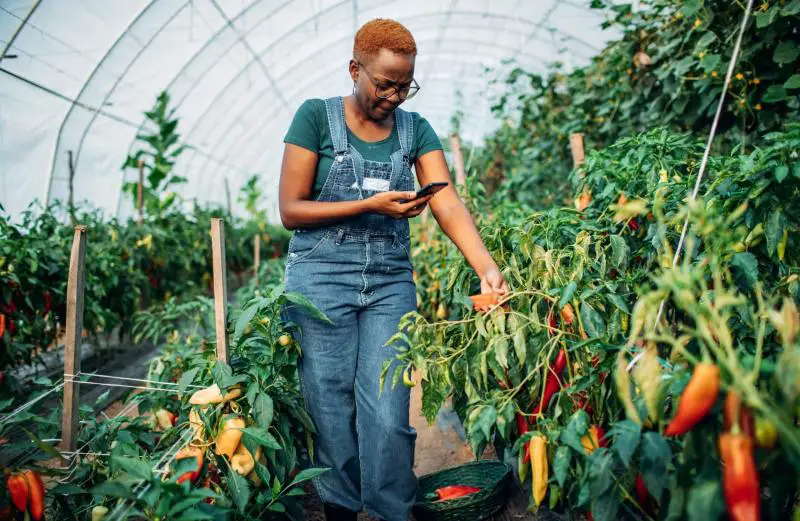Smartphone adoption in Africa remained sluggish in the latter part of the last decade. This is beginning to change as a combination of pandemic-driven demand for better connectivity and improved affordability of smartphones drive uptake.
According to a report by GSAM, by the end of 2020, 495 million people subscribed to mobile services in Africa, representing 46 per cent of the region’s population, an increase of almost 20 million in 2019. It is estimated that 615 million people in sub-Saharan Africa will subscribe to mobile services by 2025, equivalent to 50 per cent of the region’s population.
- Utilizing the development of mobile digital technologies can assist farmers in gaining access to essential data and information needed to solve certain farming management systems and underlying constraints.
- It is estimated that 615 million people in sub-Saharan Africa will subscribe to mobile services by 2025, equivalent to 50 per cent of the region’s population.
- In Uganda today, farmers can get immediate professional advice by sending photos to extension personnel and agronomists through the popular m-Omulimisa and Ezy Agric digital applications.
- In Nigeria, Sasakawa Africa Association, in partnership with the International Institute for Tropical Agriculture (IITA), is scaling up gender-responsive digital agricultural advisory services tools enabled through a WhatsApp Chatbot.

At the end of 2020, 303 million people across Sub-Saharan Africa were connected to the mobile internet, equivalent to 28 per cent of the population. By 2025, more than 170 million people across the region will have started using mobile internet for the first time, taking the penetration rate to just under 40 per cent of the population.
According to the company website, GSMA Intelligence is a definitive source of global mobile operator data, analysis, and forecasts and a publisher of authoritative industry reports and research. Their data covers every operator group, network, and MVNO in every country worldwide, from Afghanistan to Zimbabwe. GSMA Intelligence is relied on by leading operators, vendors, regulators, financial institutions, and third-party industry players to support strategic decision-making and long-term investment planning.
With mobile phone ownership racing ahead across the continent, mobile technology offers many possibilities for Africa. Harnessing the growth of mobile digital technologies can significantly help farmers access crucial information and data required to address specific farming management systems and underlying constraints.
Read: Organic farming a prototype for sustainable agriculture in Africa
Mobile digital devices such as mobile computers and smartphones, digital cameras, pagers, personal navigation devices, and wearable computers allow Africa’s farmers to access and share information with different stakeholders. These devices can be connected to remote sensing data devices that alert farmers well in advance on forthcoming climate and weather conditions such as droughts and floods. Digital technologies have also enabled farmers to obtain crucial information on soil quality for nutrient levels, water levels, pests, and disease spread, captured from various sensors, satellites, and drones.

The African continent has accomplished tremendous progress with respect to the utilization of mobile smartphones towards improving agricultural productivity.
In Uganda today, farmers can get immediate professional advice by sending photos to extension personnel and agronomists through the popular m-Omulimisa and Ezy Agric digital applications.
According to an article by Africa.com published September 14, 2022, the two platforms also allow farmers to get climate updates, report and receive alerts on pests and disease outbreaks, access inputs, markets, and financial services and communicate with their peers around the country.
Meanwhile, in Nigeria, Sasakawa Africa Association (SAA) in partnership with the International Institute for Tropical Agriculture (IITA) is scaling up gender-responsive digital agricultural advisory services tools enabled through a WhatsApp Chatbot. These applications, which are used by farmers and extension agents integrate fertilizer recommendations with relevant agronomic advisories. This also expands extension outreach. The decision-based tools for maize (Nutrient Expert), cassava (AKILIMO), and rice (RiceAdvice) also provide advice on investment prioritization between the three crops.
On the other hand, in Ethiopia farmers get information about agronomic management through Video-mediated extension learning. This is used to train farmers and accelerate extension services by screening practice videos. In addition, a bidirectional digital platform is also being used that allows information exchange with extension experts.
However, several fundamental challenges include inadequate mobile smartphone infrastructure, thus limiting African farmers’ widespread utilization of mobile digital applications for agricultural purposes. For instance, numerous parts of the African continent have limited cellphone networks and internet coverage. In addition, reliable broadband remains limited in rural areas where most agricultural activities occur.
According to an article by AUDA- NEPAD published on January 25, 2022, African governments and network service providers are encouraged to target rural areas, more especially agricultural areas, to improve the profitability of Africa’s agricultural activities. Moreover, this can also improve regulatory frameworks focusing on enabling infrastructural improvements, broadband cost-effectiveness, operational reliability, and access to internet services.
Limited technical and operational knowledge and literacy among most African farmers remain one of the significant hindrances to the adoption of mobile agricultural digital technologies. Therefore, African governments are encouraged to formulate digital technology literacy programmes and applications targeting farmers, especially farmers lacking basic education. Such efforts can improve digital technology literacy, productivity, and food security within the continent. Moreover, interventions on cost-effectiveness on the internet and data costs need to be urgently addressed to improve access to previously disadvantaged farmers. Importantly, decision-makers and policymakers are encouraged to support rural communities in adopting modern digital technologies suitable for precision agriculture.
Sasakawa Africa Association (SAA), in partnership with technology companies and research institutes, are supporting the government’s efforts toward efficient agricultural extension delivery and has trained extension personnel and farmers on how to use the digital E-Extension platforms for them to teach and support others. This became more imperative during the COVID-19 pandemic when supply chain and transport disruptions brought about production challenges. The digital E-extension technologies enabled farmers to keep engaging in farming activities.
Finally, improvements emanating from the adoption of digital technologies can encourage African farmers, the private sector, and governments to seek more digital technology applications that can boost smart agriculture.











